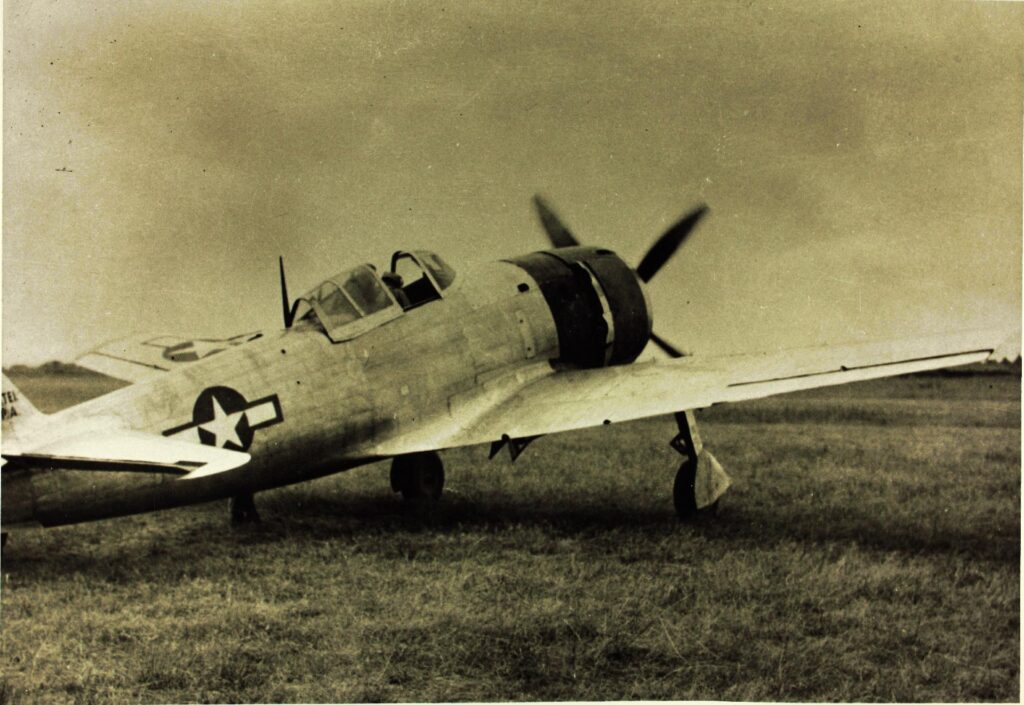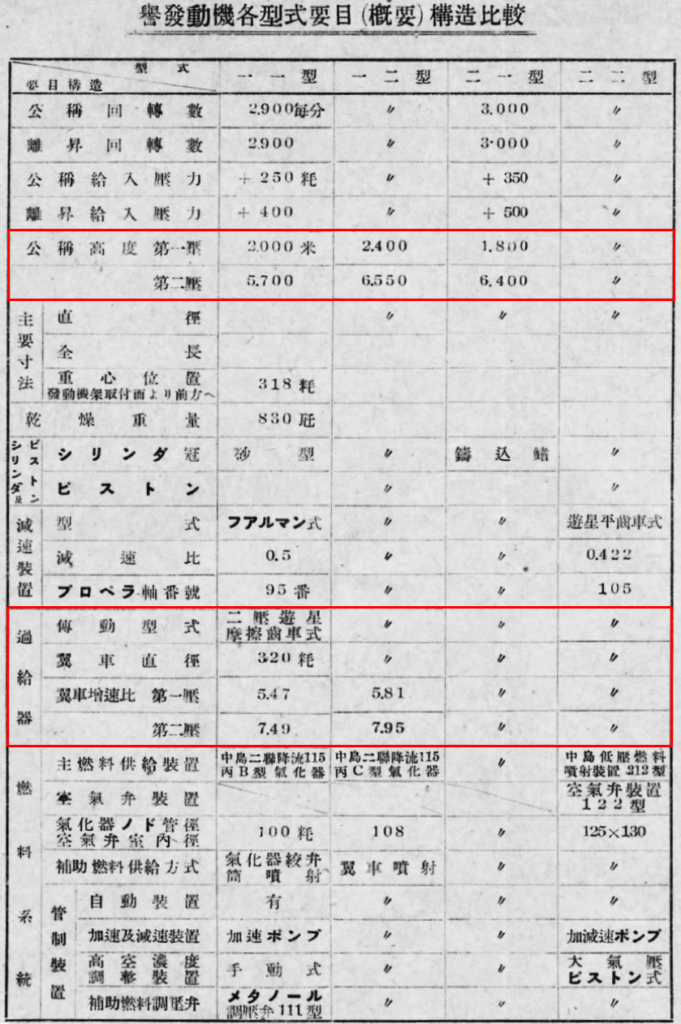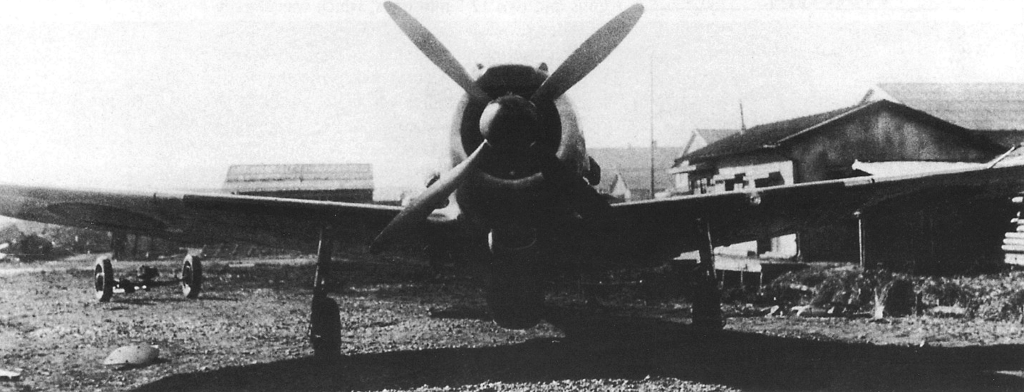This is an update to the previous article about the performance of the Type 4 Fighter (Ki-84), addressing some errors and new information that I have found since writing it.
It is not so much an article as a set of separate points.
The original article is here:

Ha-45 Special is Ha-45-11, not Ha-45-12
The engine fitted to the first three prototypes of the Ki-84 was designated the “Ha-45 Special” by the Japanese Army. Despite the name, it is in fact an inferior engine to the “Ha-45” (Ha-45-21). The “Ha-45 Special” is a Ha-45-10 series engine.
In the first article, I wrote that the “Ha-45 Special” was the Ha-45-12. In fact, it seems that the Ha-45 Special was actually the Ha-45-11. This is stated in the document「発動機名称一覧表」[Engine Designation List] created by the Navy Aviation Headquarters on April 11, 1945.
This is further supported by the document “Specifications of Special Army Planes” created by the Army Aviation Examination Dept on August 1, 1943. Here, the projected performance of Ki-84 is written to be 660km/h at 5700 meters, which is the critical altitude of the Ha-45-11. This document was captured and translated by the United States, and the relevant page is pictured below.

This is an important distinction, because the Ha-45-11 and Ha-45-12 have different altitude performance. The supercharger’s first and second speeds were stepped up 5.47⇒5.81 and 7.49⇒7.95, respectively, in the Ha-45-12. This raised the second speed critical altitude from 5700m to 6550m. Below is an excerpt from the Homare manual showing the specifications of the Model 11, 12, 21, and 22, as of December 1943.

It appears to check out that the initial prototypes were equipped with the Ha-45-11. The official performance of the Ki-84, which originates from a test with one of these prototypes, shows that the top speed was achieved at 6550 meters. This indicates that the critical altitude of the engine was increased by perhaps 850 meters due to ram pressure at the Ki-84’s top speed. It would make less sense if this plane was using a Ha-45-12, because that would indicate that there was no increase in the critical altitude from ram pressure.

Furthermore, we can see in the climb test obtained from the same aircraft that the engine began to lose manifold pressure just before 6000 meters when flying at low speed.

Ki-84 Prototype vs. Service Plane
The performance achieved by a Ki-84 prototype is considered to be the “official performance” of the Ki-84, and is written in its piloting manual. However, knowing that the Ki-84 prototype probably used a Ha-45-11 engine, we would expect the performance of a service plane to actually be somewhat different.
Mass production examples of the Ki-84 that were put into service used a Ha-45-21 engine (which the Japanese Army simply called Ha-45, or Type 4 1850 HP Engine). The Ha-45-21 was restricted to prevent engine failures, as is well known. The RPM was limited to 2900, and the manifold pressure to +250mm, just like that of the 10 series engines. With this, the critical altitude rose to about 6500m, which is essentially the same as the Ha-45-12.
Because the Ha-45-21 in its de-rated condition has (on paper) a critical altitude 800 meters higher than the Ha-45-11, as well as 60 more horsepower at critical altitude, we would expect a service Ki-84 to actually have a slightly higher top speed than the 624km/h of the Ki-84 prototype if it was operating in ideal condition.
Every Ki-84 Had Exhaust Thrust
This is not an error with the previous article but an elaboration. It is sometimes said that the early Ki-84s did not generate exhaust thrust. All units of the Ki-84 had exhaust pipes which produced thrust.
The initial prototypes and early pre-production units had a thrust-generating collective exhaust. Later, it was changed to individual thrust-generating exhaust pipes. We can be sure that the thrust force was improved to some extent, but it will not be as marked as the change from standard exhaust pipes to thrust-generating individual exhaust pipes.
For reference, the change from standard (non-thrust generating) exhaust to individual thrust-producing exhaust pipes netted the A6M5 about 10 kts (19km/h) of top speed, with its Sakae 21 engine that provided 980 HP at its top-speed altitude.
The Full-Rated Performance Gap
With a fully-rated Ha-45-21 engine, there exists a record showing a top speed of 634km/h for the Ki-84, which is referenced in the first article.

The idea that the Ki-84 only gained about 10km/h of top speed (624km/h ⇒ 634km/h) when using a “Ha-45” (Ha-45-21) engine seems difficult to believe to some. The fact that the prototype which achieved the lower speed probably had a Ha-45-11, rather than Ha-45-12 engine, makes this performance gap even more egregious.
It is relatively well accepted that the Ki-84’s propeller was inadequately sized for its class of engine, which greatly hindered its ability to make use of greater power. The Ha-45-21 had an increase in output of at least 120 horsepower compared to the Ha-45-12 their critical altitudes. However, the critical altitude of the 21 is about 400 meters lower than that of the 12 (ultimately, it is thought that the critical altitude of the fully-rated 21 was perhaps just 6100 m).
On the other hand, the Ha-45-11 not only has even less power (1440 HP at 2nd speed) than the Ha-45-12, but its critical altitude is lower than even the Ha-45-21, as previously noted. This means that the Ki-84 with a fully-rated Ha-45-21 engine had not only greater power, but at a greater altitude, and still only marked 634km/h.
Additional Evidence for Full-Rated Top Speed
The origin and condition of the fully-rated Ki-84’s 634km/h top speed record has been questioned, and though it is said to be a translated document, there is little contextual information about it.
However, there seems to be additional evidence supporting this fully-rated top speed. This comes from the document「陸軍航空技術沿革史」[History of Army Aviation Technical Development] which was published by the 1st Demobilization Bureau in May, 1947. Though it is post-war, this document was written by former staff of the Japanese Army. Within this document is the table「陸軍制式飛行機諸元表 (A)」[Army Service Airplanes Specification Table (A)].
This table lists performance for both the “Type 4 Fighter (Ki-84I)” and the “Type 4 Fighter Performance Improved“. The engine column shows that the former represents the Ki-84 with a de-rated engine, while the latter represents a plane with a fully-rated engine (referred to here as Type 4 1850HP Kai). These differing names are purely informal.
The top speed listed with the fully-rated Ki-84 is 635km/h at 6400m. The climb time is 5’50” to 5000m.

This compares closely with the values from the other fully-rated test mentioned in the last section, which showed a top speed of 634km/h at 6650m, and a climb time of 5’37” to 5000m.
I believe that 635km/h is a reasonable value for the “true performance” of the fully-rated Ki-84, on rated power. Use of “takeoff power” (essentially war emergency power, WEP) at altitude may have yielded a slightly higher top speed, but not markedly, as the critical altitude would be around 1000 meters lower.
If the Ha-45 engine was able to be produced with a compression ratio of 8.0, as was originally planned, the performance would have been greater, but this was not the case.
(The reduction of the Ha-45-21 CR from 8.0 to 7.2 is most likely the explanation for its fully-rated 2nd-speed horsepower output being reduced from the ballpark of the 1700s to the 1600s).
Expected vs. Achieved Performance
According to the “Famous Airplanes of the World” issue on the Type 4 Fighter, the required top speed issued for the Ki-84 was 680km/h, and the climb time was 4’30” to 5000m.
On the other hand, the “Specifications of Special Army Planes” document shows what seems to be a calculated or required top speed performance of 660km/h, along with the same climb time of 4’30” to 5000m.

Was the requirement reduced to 660km/h? Did Nakajima calculate 660km/h? Or was 660km/h simply the expected performance when equipped with the weaker 10-series engine? The latter would seem to be the obvious guess, but it’s not clear because the climb time remains the same.
If we interpret the expected performance of Ki-84 to be 660km/h, the actual plane seems to have fallen short by about 25km/h. The climb time, more clearly, was more than 1 minute slower than the requirement to 5000m.
Extra Explanation for the Small Performance Gap?
This last section is to be taken less seriously, and is not anything more than an idea. An awfully inadequate propeller could be the sole explanation for the lack of performance in the fully-rated Ki-84.
Anyway, the first prototype of the Ki-84 was initially completed with a smaller 19m2 main wing according to numerous secondary sources, such as the “Famous Airplanes of the World” issue. All subsequent planes had a larger 21m2 main wing, and it seems that the first unit was later modified to use the final wing.
I have not located a source which specifies which of the initial 3 Ki-84 prototypes achieved the 624km/h at 6550m top speed. If we consider the possibility that it could have been the first prototype with its original, smaller wing, it makes sense that the performance gap between this record and the fully-rated, longer-wing Ki-84 would be more negligible in terms of top speed.
It seems unlikely that the 19m2 wing unit recorded this test, however, because this performance was later used as the “official performance” of the Ki-84 in general.

Sources
- Famous Airplanes of the World No. 19: Army Type 4 Fighter ‘Hayate’. Tōkyō: Bunrindo, 2019.
- Rep. CINCPAC-CINCPOA Translations & Interrogations No. 8. 1943.
- Rep. 誉発動機取扱説明書 [Homare Engine Operating Manual]. 1943.
- Rep. 「キ八十四」操縦法 [Ki-84 Piloting Manual]. 1944.
- Rep. 発動機名称一覧表 [Engine Designation List]. 1945.
- Rep. ADVATIS Translation 92: Specifications and Performance Data of Ki-84. 1945.
- Rep. 陸軍航空技術沿革史 [History of Army Aviation Technical Development]. 1947.
Leave a Reply